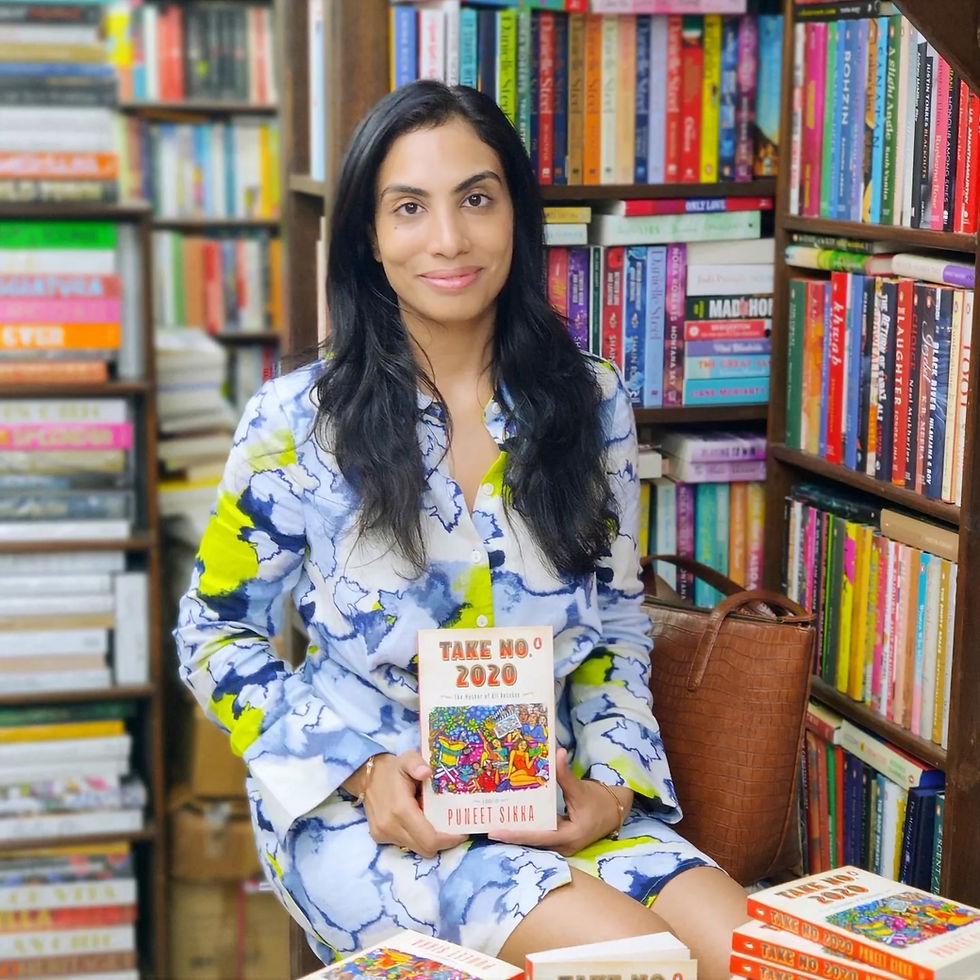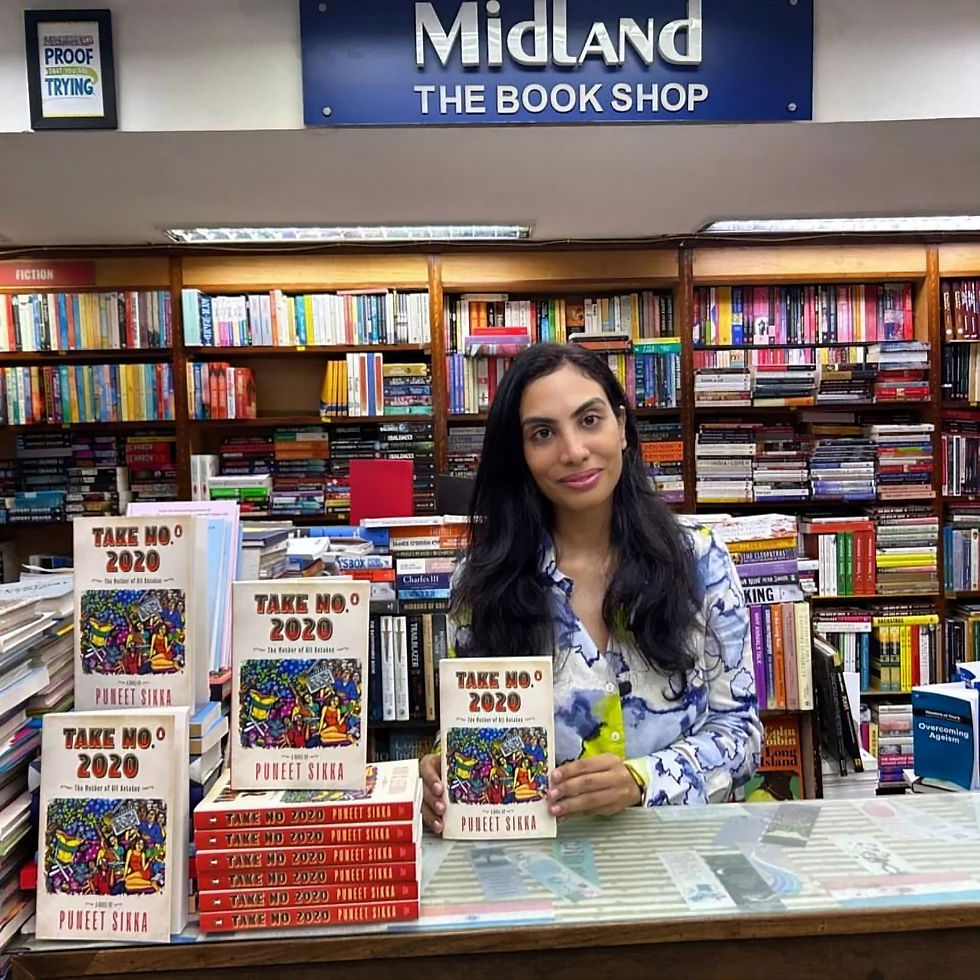
Puneet Sikka is a versatile media professional whose journey spans across writing, acting, and a profound understanding of the entertainment industry. With a background that includes working as a writer in both the news and advertising sectors, Puneet has honed her storytelling skills through various mediums.
Her debut novel, Take No. 2020, is a compelling narrative that interweaves the lives of four individuals navigating the highs and lows of the Bollywood dreamscape. Meera, who finally lands her first big Bollywood film after years of struggle, loneliness, and despair; Dabloo, whose career hits both rock bottom and its pinnacle within the same year; Jayesh, an aspiring TikTok star unlucky in love and films; and Micky Taneja, a casting couch maestro embroiled in #MeToo allegations but still searching for true love and a second chance at work. As their paths intersect, they grapple with broken relationships, unexpected connections, lost and found projects, and the resurfacing of repressed pasts, ultimately questioning whether they are the heroes or villains of their own stories.
Take No. 2020 is a vibrant blend of pop culture and realism, a "story within a story" that employs acerbic humor and poignant grief to explore the complex nature of reality and belief. This smoke-and-mirrors tale is a reflection of Puneet's lived experiences and her passion for the entertainment industry.
Puneet's educational journey took her through Lady Shri Ram College, Delhi, and the Symbiosis Institute of Media and Communication, Pune, where she refined her media acumen. Beyond her writing career, Puneet has also made a mark as an aspiring actress with performances in theatre, TV, digital commercials, short films, and a feature film. Her multifaceted career and deep engagement with the media landscape enrich her writing, making Take No. 2020 a vivid and authentic portrayal of the Bollywood dream.

1. What inspired you to write Take No. 2020 and focus on the intersecting lives of characters like Meera, Dabloo, Jayesh, and Micky Taneja?
> More than inspired, I felt compelled to tell a story that had been brewing within for quite some time. Especially, after I’d moved to Bombay and had been auditioning for roles as an actor. I’m a sponge as far as ideas and feelings are concerned, and the best way for me to process all that stimuli is to put pen to paper. By the time the year 2020 hit, I had to discard all the fanciful plots in my head, and reimagine a storyline in tune with the reality around me and the world. Meera, Dabloo, Jayesh and Mickey Taneja had been my companions from 2019 itself, so to speak, who represented a sample size of the hundred-thousands of aspiring actors from different socio-economic and linguistic backgrounds coming to Bombay to find their foothold in Bollywood. Isolating them from each other’s storylines did not feel natural, especially in the year when most people were forced to live in isolation. Intersecting the lives of these characters helped to bring out the starkness in the challenges faced by each set of people during the pandemic.
2. The book delves deeply into the struggles and complexities of the Bollywood industry. How much of this is drawn from real-life experiences or observations?
> Most creative work draws from life, eventually. And so, Take No. 2020 being my first book is largely auto-fictional, in that, I’ve drawn few references from my direct and personal experience as well from those of actor friends and acquaintances I met along the way, as well as stories one hears, watches and absorbs around themselves.
3. Your characters face a range of personal and professional challenges. How did you develop their individual arcs, and what was the most challenging aspect of their development?
> Each character was wildly different as far as preparation and development was concerned. As cliche as it may sound, the characters were writing their own arcs through me. Most part of 2020 went in scribbling post-it notes of plot points and sub plots as and when ideas came through. Not to say that I was sitting idle, but there is a subtle dance between one’s imagination at play and actually going to the playground and waiting actively, watching with a hawk’s eye, at any thought that can become the character’s motivation to take the story forward. The bizarreness of real life stories become fodder too. Once I’d gotten to the point where I knew the beginning-middle-and-end of the story and broadly the characters’ arcs, it was a jump off the cliff. Then it was mostly about adhering to the task of filling the blanks. The most challenging part was writing from the perspective of characters I did not agree with or even ‘like’ as people for that matter. Had I met them in real life, we wouldn’t have gone beyond pleasantries at the most. But in the story, they had to feel like the heroes in their own minds, which meant I had to empathise with their dark sides too.
4. The theme of identity, both public and private, is central to your book. How do you think your characters' journeys reflect broader societal issues?
> Self-identity and finding one’s place in the world is central to our existence as humans, in any case. And it’s perhaps even more amplified with actors, given that they are donning new, fictional identities as part of the their professional duty on a regular basis. Being self-absorbed as most of humankind at present generally is, the characters are no different, until their circumstances throw them for a loop. In trying to understand their role in the larger scheme of events, and in desperately seeking their answers, my sense was that the characters would act as a mirror to the societal issues. And one that hopefully the reader would be able to find resonance with. After all, it is about the collective human unconscious, which is why storytelling is never about telling a story; but always about re-telling a story.
5. Humor and grief are intertwined throughout the narrative. How did you balance these two elements to create a compelling and relatable story?
> I saw the entire story as a classic case of ‘one man’s tragedy is another man’s comedy’. It’s not to mock or ridicule anyone’s circumstances but present them as they are. Of course, I have an opinion as a writer and I did take a stand with choosing one out of many options available, to bail or find closure as the characters’ journeys unfolded. But my aim was also for the characters to find their own humour or grief in their respective situations, while simultaneously leaving it open for the reader to interpret it as per their own mindset. For instance, some people may genuinely not find any humour in a Chinese app being banned by the Indian government! Though I will admit that I let my instincts guide me at many points when it came to tempering the light and dark aspects of the events and the characters’ mindsets.
6. #MeToo allegations and the casting couch are sensitive and powerful topics. What motivated you to incorporate these into your narrative, and what message do you hope to convey?
> Sensitive and powerful aside, these topics are also, unfortunately, relevant to showbiz. Or at least, made more prominent because of the industry being in the spotlight. By virtue of being subjected to film news in our country, even the most far removed from it, find themselves aware of the shady elements at play. And so incorporating these topics into the narrative was a no-brainer. I didn’t intend to dole out any advice or proselytise, but yes, I’ve always been fascinated with themes of human endurance and personal growth in challenging circumstances in stories and in life and that may have unconsciously seeped into mine as well.
7. The concept of a "story within a story" plays a significant role in Take No. 2020. Can you elaborate on how you utilized this technique and its significance to the overall narrative?
> As I mentioned earlier, after a while the story was writing itself. And honestly, I discovered this happy coincidence of a ‘story within a story’ only once I had finished writing the book. I could say more, but for that, I’ll have to give out spoilers which I would like to avoid at this stage. The book is easy to visualise and it made sense to adopt that style of writing since the setting and theme is film-based.
8. How do you think the setting of Bollywood, with its glamour and darker sides, enhances the themes and conflicts in your book?
> Between Bollywood having a low entry barrier for newcomers, to them finding a foothold as a performer or creator and to then thriving in the industry, the journey is replete with challenges and oddities that has often been the raw material for countless tales already. Each character is caught somewhere in this spectrum which is the primary plot. And then comes the year of the most – 2020, which only intensifies The Hunger Games like situation. The characters are furiously doggy-paddling to keep their heads above water, where only time will be the judge of who floats and who drowns. I can only say that the proof of the pudding is in the eating, which in this case means, reading the book to find out exactly how that happens. :)
9. What was your research process like for this book, particularly regarding the intricacies of the film industry and the personal struggles of your characters?
> As far as the film industry is concerned, a lot of the research came from observations and my own lived experience. I’ve come to understand that no amount of formal training and certified education can give as much insight into the industry as working in the system and learning on the job does. This knowledge helped me create the framework within which Meera, Dabloo, Jayesh and Mickey would operate. But for the purpose of their individual graphs, especially which required more specialised understanding, I consulted experts – like doctors for instance. Even casual but intentional conversations with actor-friends, casting agents and even a television news anchor were helpful.
10. Looking at the journey of your characters, do you believe they find redemption or resolution by the end of the book? How important was it for you to leave some aspects open to interpretation?
>There is no definitive answer to this question, not just in context of my book, but for life in general too. Many times, redemption itself ‘is’ the resolution or is ‘in’ the resolution. To be a little cheeky and quote the character Sarita’s dialogue from my book, “Sometimes there’s a disconnect between what we want from life and what we resign ourselves to”. From some initial feedback I had gotten on the book, the readers had mentioned that they found themselves playing a guessing game at various junctures at which the characters found themselves. Few that they had foreseen and few that they hadn’t and a different resolution to the one they had imagined ended up surprising them. Even if Take NO. 2020 is a story within a story, to me it is as real as life gets. And real life is experienced in the in-between, which is always open to interpretation by whomsoever we allow to participate in it. The year 2020 proved that fact is stranger than fiction, and the book is only an extension of that.
Comments